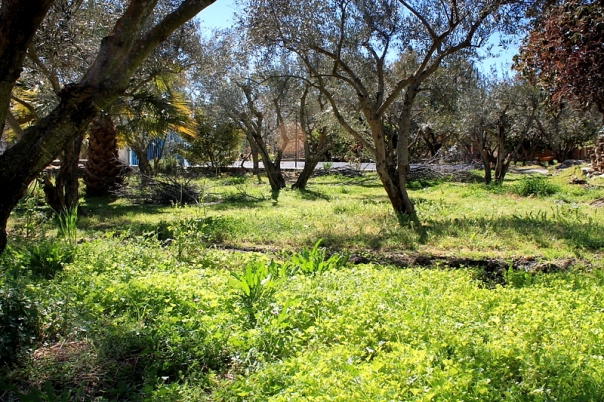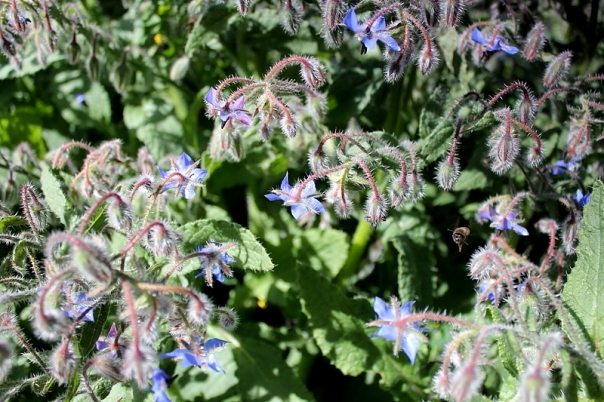 CONFLICTING theories concerning husbandry jostle beneath the olives. Traditionally, here in the Alpujarras, the earth beneath the trees should be kept bare to ensure every droplet of water is drawn up into the fruit. An alternative train of thought is that groundcover should be encouraged to insulate the soil and prevent evaporation. It’s all very scientific, but in a basic sort of way . . .
CONFLICTING theories concerning husbandry jostle beneath the olives. Traditionally, here in the Alpujarras, the earth beneath the trees should be kept bare to ensure every droplet of water is drawn up into the fruit. An alternative train of thought is that groundcover should be encouraged to insulate the soil and prevent evaporation. It’s all very scientific, but in a basic sort of way . . .
On my wanderings I meet a chap called Chris. He tells me that groundcover is essential and works on several levels because it attracts insects – which enhance plant fertility – and captures the early-morning dew. For these reasons it should not be cut back. Bare earth is old thinking.
I like the sound of capturing dew. It has a mediaeval feel to it. Dew ponds, perch ponds, rambling herb gardens and the call to vespers. That sort of thing.
 So I allow my groundcover to flourish. This is an easy and not unpleasant task, and one I can recommend to gardeners everywhere. Bees buzz and birds sing amid my carpet of rich greens. And from the earth spring strange plants, the most prevalent of which are barley and borage.
So I allow my groundcover to flourish. This is an easy and not unpleasant task, and one I can recommend to gardeners everywhere. Bees buzz and birds sing amid my carpet of rich greens. And from the earth spring strange plants, the most prevalent of which are barley and borage.

 Barley was once a staple crop in this part of Andalucia, so it’s not surprising it seems to flourish everywhere. The remains of circular threshing floors can be found in remote areas, high in the mountains and down in the valleys.
Barley was once a staple crop in this part of Andalucia, so it’s not surprising it seems to flourish everywhere. The remains of circular threshing floors can be found in remote areas, high in the mountains and down in the valleys.

 Borage is native to the Mediterranean and can be eaten as a vegetable. According to Wikipedia, the Germans use it in grüne soße (green sauce), the Mexicans in salsa verde (which sounds like the same thing), the Italians stuff ravioli and pansoti with its leaves, and in Poland it is used to flavour the national delicacy – pickled gherkins.
Borage is native to the Mediterranean and can be eaten as a vegetable. According to Wikipedia, the Germans use it in grüne soße (green sauce), the Mexicans in salsa verde (which sounds like the same thing), the Italians stuff ravioli and pansoti with its leaves, and in Poland it is used to flavour the national delicacy – pickled gherkins.
And because I’ve just planted some gherkins, this leads almost seamlessly to my next post. I love it when that happens . . .
And we love it too! Welcome back…….you’ve been quiet, busy gardening? Sounds like bee-gardening to me. We need more pollinators……glad you’ve got the bug!
LikeLike
Hi Ash. Yes, very busy and also feeling a bit rudderless, as people do when taking retirement – or being springboarded into it, in my case. So I thought I’d better shake myself out of it and focus on some goals, and writing posts is one of them. It’s also more enjoyable than DIY.
Cheers, Alen
LikeLiked by 1 person
Very interesting post and wonderful pictures, Alen. I came to think of wine yards where they plant roses. But not for pollination as for an early warning of mildew. It is always fascinating when one utilize nature in the most attractive way.
Great to read the news from you,
Hanna
LikeLiked by 1 person
Hej, Hanna. That’s interesting about the mildew. We have plenty of roses and also some vines, so I will read up on that. I’ve always found that the best way to combat nature’s nasties is to use nature against them, rather than resorting to chemicals. Thanks for the information.
Cheers, Alen
LikeLiked by 1 person
Pleased to see your ground cover is flourishing. Olive plantations are the flattest places to camp on in Spain, often a bit on the stony side though.So all that herbage would help soften the bed – has Borage any soporific properties?
LikeLiked by 1 person
John, you can pitch your tent on my patch of ground any time you want – but all day yesterday it was under an inch of water after heavy rain. That’s great for the ground but not so good for camping. Borage has loads of medicinal uses but, so far as I can see, no soporific value. This is what Wikipedia says: “Traditionally, Borago officinalis has been used in hyperactive gastrointestinal, respiratory and cardiovascular disorders, such as gastrointestinal (colic, cramps, diarrhoea), airways (asthma, bronchitis), cardiovascular, (cardiotonic antihypertensive and blood purifier), urinary (diuretic and kidney/bladder disorders). Naturopathic practitioners use borage for regulation of metabolism and the hormonal system, and consider it to be a good remedy for PMS and menopause symptoms such as the hot flash [I think this should be ‘hot flush’, but I’m not an expert in this field]. The flowers can be prepared in infusion.”
Apparently, borage flowers are also used in the Pimm’s Cup cocktail. This may or may not be of any use to you.
Cheers, Alen
LikeLike
Pimm’s isn’t drunk up North, as you well know, so maybe we should use our borage as an infusion in Tetley’s to combat the ‘hot flashes’
LikeLike
Ha ha. Thanks for the laugh.
LikeLike
Lovely sunny photos. I believe in ground cover around trees as that’s what they’d naturally have. There would always be leaves under the trees rotting away and that would all be left. That would encourage other plants to grow in the then nutritious soil. Can’t imagine where the bare earth thing came from as it does encourage evaporation – especially in a hot country. I think you can also scorch roots which are near to the ground too.
Carol.
LikeLiked by 1 person
Some points there I hadn’t thought of, Carol. Yes, the groundcover, along with falling leaves, rots down over time and adds to the richness and volume of the soil. Also, it’s the natural thing, because that’s what happens in the wild. I don’t know how this bare earth tradition started but it’s very widespread, to the point that whenever we have high winds, great dust clouds rise from the land. Very puzzling. Still, that’s what they do.
All the best, Alen
LikeLike
I can never understand why people burn their leaves – I put them back on the garden under the bushes to rot down and recycle the nutrients
LikeLike
I’ve been composting mine for years. The village we lived in near Darlington had many mature trees around the village green. People complained like mad when the leaves fell in autumn and some even wanted to chop the trees down. I used to gather sack fulls of dry leaves to carpet the hen run. Then after the hens had messed with them they went on the compost heap.
LikeLike
I just get barrowloads from the bus stop in the village and heap them on the garden – I don’t bother composting them first as I believe that’s how nature dumps them so it must be automatic! 😉
LikeLiked by 1 person
Sounds good to me!
LikeLike
Can’t wait for the article on pickled gherkins.
I can see both sides of the debate on covering soil or not, but if the trees flourish with groundcover then that seems to be a win win situation. (No competing for nutrients, evaporation caught, better biodiversity.) And it looks so much better. There are times when a bare ground forest looks good, beech woodland for example, but seeing a bluebell wood in full bloom is one of the wonders of the calendar.
And you’ve started to find old workings too (circular threshing floors). Just a matter of time before the discarded Fray Bentos turns up.
LikeLiked by 1 person
Hi Chris. The threshing floors are quite common (and protected by legislation, apparently) but very hard to photograph because they are big and flat. I thought I’d found a railway goods wagon the other day, surrounded by trees, but when I fought my way through it was an old caravan painted green. Very disappointing. No Fray Bentos yet, either.
You’ve got me yearning for home now with talk of bluebell woods. The most beautiful I’ve ever seen where somewhere along the Cleveland Way, in the vicinity of Guisborough, I think.
Cheers, Alen
LikeLiked by 1 person